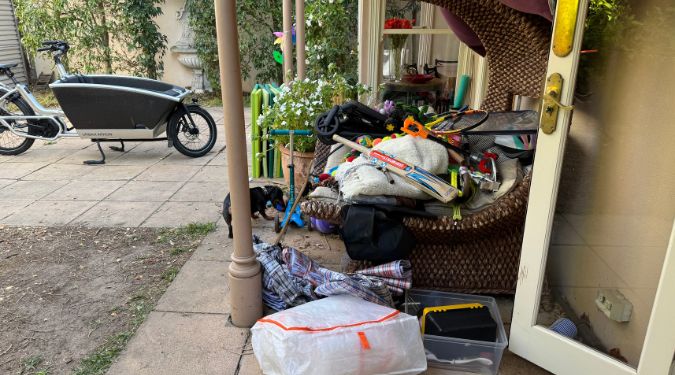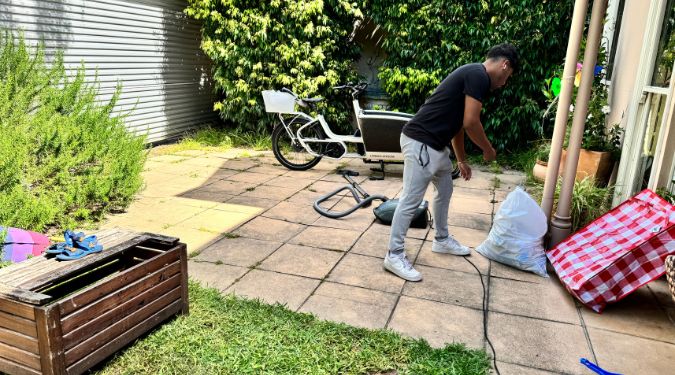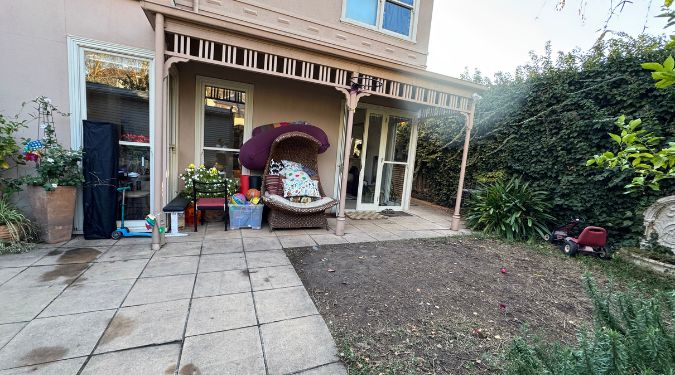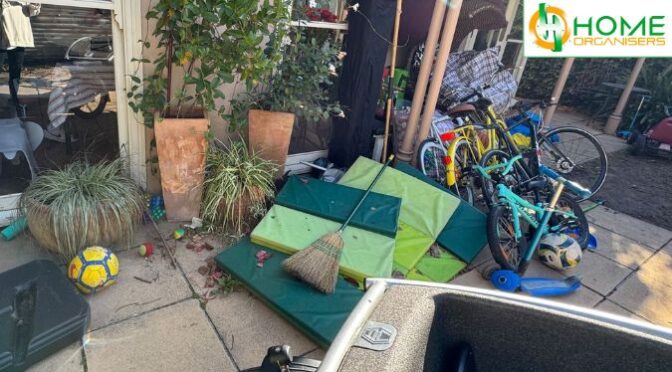Hoarding isn’t just about having too much stuff. It’s a serious issue that can affect every part of a person’s life. It can also deeply impact their health, safety, and relationships with family and friends. For professionals—such as support workers, NDIS providers, mental health staff, or carers—it’s important to understand what hoarding is, why it happens, and how to help someone gently and safely transform their home into a place of calm, not chaos.
This guide is here to explain hoarding clearly and offer practical steps for helping people who live with it. We’ll explore it from many angles—health, emotions, family, money, and more—to give you a full picture of how it affects people and how we can support positive change.
What is Hoarding?
Hoarding occurs when a person finds it hard to get rid of items—even things that seem unimportant or useless to others. Over time, their home becomes filled with objects, making it hard to live normally. There may be piles of newspapers, old clothes, broken items, food containers, or even rubbish stacked everywhere.
Hoarding is not laziness or messiness. It’s often linked to:
- Trauma or past loss
- Anxiety or depression
- OCD (Obsessive Compulsive Disorder)
- Perfectionism or fear of making the wrong decision
It’s a mental health condition. That’s why the solution isn’t just cleaning—it’s supporting the person in a respectful, caring way, often with professional hoarding help.
Health and Safety: The Hidden Dangers Inside
A home affected by hoarding may look like just a big mess, but there are often serious risks hiding underneath the clutter.
Physical Health Risks:
- Mould and mildew from damp or rotting items
- Pest infestations like cockroaches, rodents, or flies
- Dust and allergens that make breathing harder
- Blocked exits that make it hard to leave in an emergency
- Fire hazards from overloaded power points or flammable items
These can lead to long-term illnesses, asthma attacks, injuries, or even death. These are common NDIS environment risks that need careful management.
Mental Health Impact:
Living in clutter can make someone feel:
- Stressed and overwhelmed
- Depressed or hopeless
- Ashamed, leading them to isolate and avoid help
- Trapped, like their situation will never change
Even support workers can feel anxious or unsure when stepping into such environments for the first time. That’s why it’s vital to take a calm, step-by-step approach using appropriate safety interventions.

The Emotional Side of Hoarding
Every item in a hoarder’s home may hold emotional meaning. A broken lamp might remind them of their mum. A stack of old newspapers might feel like security. Throwing away items, for them, can feel like losing a part of themselves.
That’s why forceful clean-ups often do more harm than good.
Support workers and professionals must take a trauma-informed approach. This means:
- Understanding that clutter is often a coping tool
- Asking permission and explaining each step
- Being patient, even when progress is slow
- Celebrating small wins, like clearing one chair or table
This approach builds trust and encourages the person to stay involved in the clean-up journey.
Family Relationships and Social Life
Hoarding often puts a strain on families. Loved ones may feel frustrated, angry, or even helpless watching someone they care about live in unsafe conditions. There might be arguments, broken trust, or distance.
Children of hoarders might grow up feeling embarrassed to bring friends home. Partners may feel like their home is being taken away from them. Family events may stop altogether.
A successful hoarding intervention can:
- Restore peace at home
- Bring families back together
- Create a safer space for children
- Encourage social connection and confidence
The home becomes a welcoming place again—not a source of shame.

Productivity and Daily Functioning
A hoarded home often becomes unusable.
- The kitchen may be too full to cook
- The bathroom may be blocked or unsanitary
- Clothing may be hard to find or clean
- Simple tasks like paying bills, taking medication, or getting dressed can become overwhelming
When a person can’t use their home properly, their entire routine breaks down. They may stop going to work, miss appointments, or avoid visitors.
Clearing and organising the home brings back structure, routine, and independence. People can start setting goals again and living more freely.
Mood, Motivation, and Wellbeing
It’s easy to feel low in a cluttered space. Research shows that messy, chaotic environments can make the brain feel stressed and anxious. It becomes hard to focus, sleep well, or make decisions.
When the space becomes clear and safe, a person’s mood often improves dramatically.
- They feel calmer
- They sleep better
- They begin to enjoy their space
- Their self-worth increases
A clean home isn’t just about looks—it helps people feel better inside and out.

Financial Consequences of Hoarding
Hoarding can affect a person’s finances in many hidden ways:
- Buying items they already own, but can’t find
- Missed bills and fines because of lost paperwork
- Repair costs for damages caused by clutter
- Lost income due to not being able to work or host clients
- Eviction or housing issues if the property becomes unsafe
Helping someone get their home back in order can improve their financial stability, help them budget better, and reduce waste.
Step-by-Step: A Practical Guide for Professionals
If you’re a professional supporting someone with hoarding challenges, here are some key steps:
Step 1: Build Trust
Start with kind conversations, not pressure. Show respect for their space and their story.
Step 2: Assess Risks
Check for urgent hazards—blocked exits, fire risks, pests, or structural dangers. Make safety the priority using the right safety interventions.
Step 3: Create a Plan
Work room by room, setting small, clear goals. Involve the person in planning so they feel in control.
Step 4: Work With Experts
Partner with experienced clean-up teams that specialise in professional hoarding help, especially those who understand trauma and mental health.
Step 5: Include Support Services
Link in mental health professionals, NDIS services, or family therapy where needed. This ensures long-term support and minimises NDIS environment risks.
Step 6: Maintain the Progress
Once the space is cleared, set up systems to keep it that way. This might include:
- Regular check-ins
- A calendar for small tasks
- Simple storage solutions
- Ongoing professional support
What Makes a Hoarding Clean-Up Different?
Unlike a regular house clean, a hoarding clean-up needs:
- Emotional sensitivity
- Biohazard knowledge
- Specialist equipment
- Non-judgemental support
At Home Organisers, we’re trained to handle hoarding cases with care and professionalism. We work closely with families and support workers to make the process as smooth as possible.
Our approach is focused on dignity, safety, and long-term solutions—not just “getting rid of stuff.”
Creating a Future With Less Stress
Hoarding can be overwhelming for the person living in it and for the people trying to help. But with the right support, change is possible.
A clear, functional home means:
- Better health
- More confidence
- Peace of mind for family
- Time and space for hobbies or work
- A sense of pride
Most importantly, it gives someone back control over their life and surroundings.
Final Thoughts: Kindness First, Always
It’s easy to look at a hoarded space and think, “Just throw it all out.” But remember: every item might have a story for the person living there. And behind every story is a person who may be hurting, afraid, or stuck.
Professionals have the power to help—not by rushing in with black bags and boxes, but by listening, planning, and supporting gently.
If we meet people with understanding, not judgement, we help them take the first step from a cluttered home toward a healthier, happier future.
Need expert support with a hoarding situation?
Contact our friendly team today on 03 8583 9103, email nancy@homeorganisers.com.au, or visit homeorganisers.com.au to learn how we can help restore safety, dignity, and peace of mind.
Case Study 1: Restoring Safety and Dignity for an NDIS Participant Living in Extreme Clutter
Client: “Paul”, a 61-year-old NDIS participant living alone in suburban Melbourne
Challenge: Severe hoarding, blocked exits, and pest infestation
Background:
Paul had been living alone for over a decade following the death of his wife. Over time, grief and isolation led him to accumulate newspapers, clothes, broken appliances, and unused household items. His support coordinator became concerned after a home visit revealed that Paul’s living room and kitchen were completely unusable, with walkways barely wide enough to move through.
The home posed serious NDIS environment risks—including tripping hazards, mouse infestations, and a mouldy bathroom. Paul was also skipping meals because he couldn’t access his stove or fridge. Despite these dangers, he was deeply attached to many of his items and was anxious about the idea of a clean-up.
The Process:
With compassion at the core, Home Organisers stepped in to provide professional hoarding help. The team worked closely with Paul’s NDIS support coordinator and mental health professional to design a trauma-informed, step-by-step plan.
We began with a risk assessment, prioritising safety interventions: clearing emergency exits, checking electrical hazards, and addressing biohazards. Paul was included in every decision, from sorting categories to choosing what stayed or went. We used a “room-by-room” method and celebrated small wins to maintain his confidence.
Outcome:
In just four weeks, Paul’s kitchen, bathroom, and bedroom were restored to functional, clean, and safe condition. He began preparing meals again, welcomed support workers more comfortably, and even invited his sister over for the first time in years.
Today, Paul receives monthly maintenance visits and mental health support to ensure ongoing progress. The transformation wasn’t just physical—it improved his mood, dignity, and overall wellbeing.
Case Study 2: Helping a Family Reclaim Their Home and Rebuild Trust After Years of Hoarding
Client: “Rita”, a 47-year-old single mother of two teenage children
Challenge: Chronic hoarding affecting the emotional wellbeing of her family
Background:
Rita had quietly struggled with hoarding for more than 10 years. Her home was overflowing with clothing, second-hand toys, and unused baby items. Her teenage children were sleeping on mattresses in the living room, as their bedrooms had become too cluttered to use. The clutter had escalated to the point where home safety, privacy, and hygiene were severely compromised.
The children’s school had raised concerns, prompting a referral from a family services worker. The home had become a high-risk zone for respiratory issues, stress, and social isolation—all major NDIS environment risks for a family already facing challenges.
The Process:
Home Organisers was brought in to deliver compassionate, trauma-aware professional hoarding help. Understanding the emotional weight of the situation, we involved Rita and her children in the clean-up plan while working alongside a family therapist.
Our approach focused on key safety interventions first—unblocking fire exits, restoring access to the bathrooms, and ensuring safe sleeping arrangements. We then slowly cleared the children’s rooms with their involvement, taking care to preserve sentimental items and allow for ownership over their spaces.
Throughout the process, we held regular check-ins with Rita to manage emotional overwhelm and decision fatigue. We also supported her in donating many items to causes she cared about, making letting go feel more purposeful.
Outcome:
In just under six weeks, the home was transformed. The children regained their bedrooms and study space, the kitchen became functional again, and the entire family reported feeling “lighter and less anxious.” Rita began seeing her home as a safe space rather than a source of shame.
Ongoing family therapy and light decluttering support have kept the space in check. The home is now not just cleaner—but healthier, safer, and more nurturing for everyone.
FAQs – From Hidden Hazards to Healthy Homes: Supporting Clients in Hoarding Situations
- 1. How do I help a loved one who’s struggling with hoarding without hurting their feelings?
Supporting someone with hoarding tendencies can be tricky. This FAQ explores gentle, respectful ways to begin the conversation, build trust, and avoid conflict while offering real help.
- 2. What makes hoarding clean-up different from a regular house clean?
Many people don’t realise hoarding clean-ups involve safety concerns, mental health factors, and emotional support. This FAQ explains the specialised approach we take and why compassion matters just as much as the clean-up itself.
- 3. Is it normal to feel overwhelmed, ashamed, or anxious about asking for help with hoarding?
This addresses the common emotional struggles people face when reaching out, helping them feel less alone and more empowered to take the first step.
- 4. Can hoarding clean-up really improve someone’s mood, health, and daily life?
A powerful explanation of the real, life-changing benefits — not just physical, but mental, emotional, and even financial — of restoring a safe, organised home.
- 5. What if the person I care about refuses help or doesn’t believe they have a hoarding problem?
This FAQ gently covers how to navigate denial, resistance, and fear while staying supportive and respectful.
- 6. What risks are we living with by delaying a hoarding clean-up?
Highlights the hidden dangers — from fire hazards to health issues — that may not be obvious until they become serious.
- 7. How involved will my loved one need to be in the clean-up process?
This question helps families and professionals understand how to work with the individual, not around them, and explains why collaboration is key to long-term change.
- 8. Is hoarding clean-up covered under the NDIS or other support plans?
A helpful guide for NDIS participants, carers, and support coordinators who want to know how hoarding support may fit into their existing plans.
- 9. I’m a support worker — how do I know when it’s time to call in professional hoarding help?
Designed for case managers, NDIS support staff, or social workers, this FAQ helps identify signs that the situation needs specialist intervention.
- 10. After the clean-up, how do we help someone keep their home safe and clutter-free?
Focuses on long-term solutions, such as maintenance plans, mental health support, and follow-up visits to prevent relapse and support lasting wellbeing.


